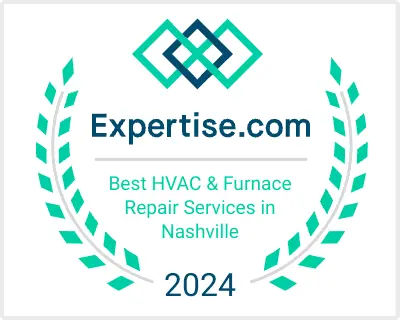Did you know September and October 2023 will be slightly drier in Goodlettsville, TN? Despite that, experts still forecast the city to experience thunderstorms during these months.
Along with those thunderstorms comes an increased risk of power outages. These events have become more common in Tennessee and have gotten longer, too. In 2021, the average TN customer experienced 5 hours of power outage compared to the 2.9-hour average in 2013.
Even more concerning is that fall storms and power outages can damage your HVAC system.
Fortunately, following an HVAC maintenance checklist can help reduce such risks. With this, you can prepare your HVAC for fall storms, power outages, and the damage they can bring.
We’ve rounded up the top tasks your checklist should contain, so read on.
Invest in a Surge Protector
A power surge is an electrical event involving a sudden or unexpected rise in voltage. They can be powerful enough to damage and fry electronic equipment. A typical home in the U.S. has equipment worth about $15,000 that such incidents can destroy.
A power surge can occur after an outage and once electricity returns. It can also happen due to lightning hitting power systems or grids.
A surge protector can help prepare your HVAC for storms, lightning, and outages. Your local mechanical contractors can assist with its installation.
Surge protectors act like a “shield” for electronic equipment, including HVAC systems. They absorb and diffuse unwanted, excess voltage.
You can get an HVAC-specific surge protector or a whole-house one. If you opt for the former, you’d need two: one for the indoor unit and the other for the outdoor unit.
Turn Your HVAC off During Outages
A surge protector’s lifespan depends on how often it deals with power surges. Because of this, you must regularly inspect your surge protector. Most have a warning light that blinks, indicating they need a replacement.
Not all surge protectors have warning lights, though. This can leave you unsure if it still works following an outage.
In that case, your best bet is to turn off your HVAC system at the thermostat and circuit breaker. This way, you don’t have to worry about a power surge damaging it if your surge protector has already failed.
Once power returns, wait at least half an hour before switching the HVAC circuit breaker back on. Think of this as a leeway for the voltage to return to normal.
After 30 minutes, you can turn the HVAC circuit breaker and thermostat back on.
Eliminate Debris From the Outdoor Unit
Does the HVAC system in your Goodlettsville home have an outdoor unit? If so, know it contains the compressor, condenser, and fan. Among their many jobs is to expel the warm air the system has absorbed from inside your home.
Since it sits outside, the outdoor HVAC unit can quickly accumulate fall foliage. The odds of this happening are higher during and after fall storms.
Aside from fallen leaves and twigs, dust, debris, and even small trash can clog the outdoor unit up. Weeds can also grow around it.
If you let those things clog your outdoor unit up, they can cause your HVAC system to overheat and seize up. Thus, caring for your HVAC during fall involves keeping the outdoor unit free of debris.
Make it a habit to inspect and clean the outdoor unit once a month or after every rain or storm. You should also relocate plants and remove weeds growing nearby. Lastly, ensure all sides have a clearance of at least two feet.
Inspect the Outdoor Unit’s Padding
Another vital part of fall HVAC storm prep and maintenance is to check the condenser pad.
The condenser pad is a thick, heavy, elevating material where your outdoor HVAC unit sits. It raises and stabilizes the unit and minimizes water exposure and collection. It also protects the outdoor unit from critters.
Over time, the pad’s weight can drag it down and make it sink. It may also become uneven if the soil underneath erodes. Such problems can put your outdoor unit at risk of stormwater, critters, and tipping over.
A degrading or sinking condenser pad can also pull the coolant lines. This can damage or dent them, potentially causing refrigerant leaks.
Before any of that happens, inspect your condenser pad. Ensure it’s even, stable, and at least three inches off the ground.
If the pad is wobbly or has sunk, call an HVAC repair specialist in Goodlettsville, TN, ASAP. They can fix or replace the padding before it exposes your outdoor HVAC unit to more severe problems.
Mind Your HVAC Filters
Goodlettsville’s fall foliage may be stunning, but it also invites molds. Once leaves fall and decay, they become a breeding ground for these microscopic fungi. Storms hasten this process, as they can force trees to drop more of their leaves.
Molds and mold spores can enter your home through open doors, windows, and air vents. Fortunately, your HVAC system’s air filters help capture some of these organisms. However, it’s also due to this that your air filters can quickly clog up.
Clogged air filters can reduce your HVAC system’s efficiency. It would have to work harder, placing unnecessary strain on its components. Over time, this can result in early system wear, tear, and failure.
That’s why you should regularly clean or replace your HVAC filters during fall. A good rule of thumb is to check it monthly. If it looks dirty, wash or change it; doing so can also lower your system’s energy use by 5% to 15%.
Keep This HVAC Maintenance Checklist Handy
Remember: New HVAC systems cost thousands of dollars. That makes them some of the most expensive residential equipment.
That’s enough reason to make your existing one last for as long as possible. And with this HVAC maintenance checklist, you’re more likely to achieve that goal. It can help protect your system from damaging fall storms, power outages, and surges.
As a final tip, schedule your HVAC system for semi-annual maintenance. Lanham Mechanical Contractors’ expert technicians will gladly do this for you. So, call us now for all your HVAC needs in Goodlettsville, TN!



